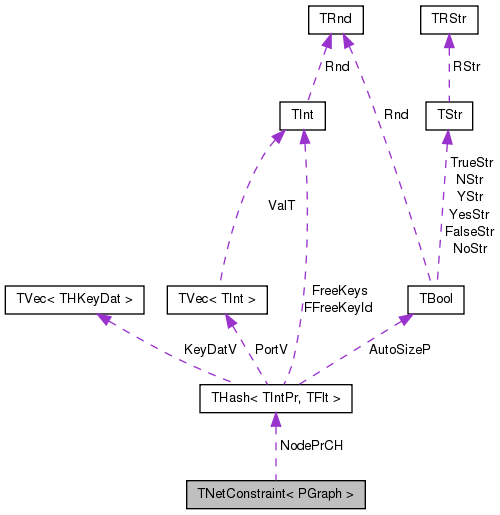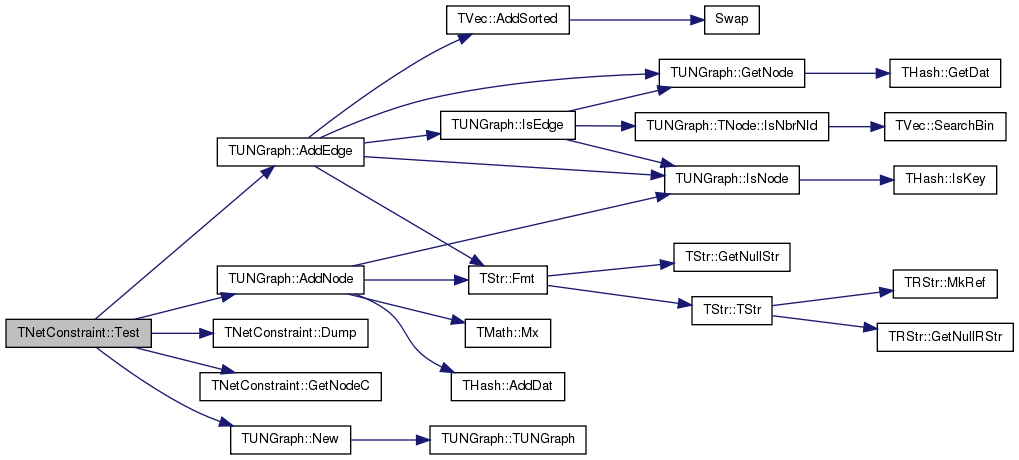|
SNAP Library 2.2, Developer Reference
2014-03-11 19:15:55
SNAP, a general purpose, high performance system for analysis and manipulation of large networks
|
|
SNAP Library 2.2, Developer Reference
2014-03-11 19:15:55
SNAP, a general purpose, high performance system for analysis and manipulation of large networks
|
#include <triad.h>

Public Member Functions | |
| TNetConstraint (const PGraph &GraphPt, const bool &CalcaAll=true) | |
| int | Len () const |
| double | GetC (const int &ConstraintN) const |
| TIntPr | GetNodePr (const int &ConstraintN) const |
| double | GetEdgeC (const int &NId1, const int &NId2) const |
| double | GetNodeC (const int &NId) const |
| void | AddConstraint (const int &NId1, const int &NId2) |
| void | CalcConstraints () |
| void | CalcConstraints (const int &NId) |
| void | Dump () const |
Static Public Member Functions | |
| static void | Test () |
Public Attributes | |
| PGraph | Graph |
| THash< TIntPr, TFlt > | NodePrCH |
| TNetConstraint< PGraph >::TNetConstraint | ( | const PGraph & | GraphPt, |
| const bool & | CalcaAll = true |
||
| ) |
Definition at line 482 of file triad.h.
References TNetConstraint< PGraph >::CalcConstraints(), CAssert, gfMultiGraph, and HasGraphFlag.
: Graph(GraphPt) { CAssert(! HasGraphFlag(typename PGraph::TObj, gfMultiGraph)); // must not be multigraph if (CalcaAll) { CalcConstraints(); } }

| void TNetConstraint< PGraph >::AddConstraint | ( | const int & | NId1, |
| const int & | NId2 | ||
| ) |
Definition at line 518 of file triad.h.
References TMath::Sqr().
{
if (NId1==NId2 || NodePrCH.IsKey(TIntPr(NId1, NId2))) {
return;
}
typename PGraph::TObj::TNodeI NI1 = Graph->GetNI(NId1);
double Constraint = 0.0;
if (NI1.IsOutNId(NId2)) { // is direct edge
Constraint += 1.0/(double) NI1.GetOutDeg();
}
const double SrcC = 1.0/(double) NI1.GetOutDeg();
for (int e = 0; e < NI1.GetOutDeg(); e++) {
const int MidNId = NI1.GetOutNId(e);
if (MidNId == NId1 || MidNId == NId2) { continue; }
const typename PGraph::TObj::TNodeI MidNI = Graph->GetNI(MidNId);
if (MidNI.IsOutNId(NId2)) {
Constraint += SrcC * (1.0/(double)MidNI.GetOutDeg());
}
}
if (Constraint==0) { return; }
Constraint = TMath::Sqr(Constraint);
NodePrCH.AddDat(TIntPr(NId1, NId2), Constraint);
}

| void TNetConstraint< PGraph >::CalcConstraints | ( | ) |
Definition at line 542 of file triad.h.
Referenced by TNetConstraint< PGraph >::TNetConstraint().
{
// add edges
for (typename PGraph::TObj::TEdgeI EI = Graph->BegEI(); EI < Graph->EndEI(); EI++) {
AddConstraint(EI.GetSrcNId(), EI.GetDstNId());
AddConstraint(EI.GetDstNId(), EI.GetSrcNId());
}
// add open triads
for (typename PGraph::TObj::TNodeI NI = Graph->BegNI(); NI < Graph->EndNI(); NI++) {
for (int i = 0; i < NI.GetDeg(); i++) {
const int NId1 = NI.GetNbrNId(i);
for (int j = 0; j < NI.GetDeg(); j++) {
const int NId2 = NI.GetNbrNId(j);
AddConstraint(NId1, NId2);
}
}
}
NodePrCH.SortByKey();
}

| void TNetConstraint< PGraph >::CalcConstraints | ( | const int & | NId | ) |
Definition at line 563 of file triad.h.
References THashSet< TKey, THashFunc >::AddKey(), and THashSet< TKey, THashFunc >::IsKey().
{
typename PGraph::TObj::TNodeI StartNI = Graph->GetNI(NId);
TIntSet SeenSet;
for (int e = 0; e < StartNI.GetOutDeg(); e++) {
typename PGraph::TObj::TNodeI MidNI = Graph->GetNI(StartNI.GetOutNId(e));
AddConstraint(NId, MidNI.GetId());
for (int i = 0; i < MidNI.GetOutDeg(); i++) {
const int EndNId = MidNI.GetOutNId(i);
if (! SeenSet.IsKey(EndNId)) {
AddConstraint(NId, EndNId);
SeenSet.AddKey(EndNId);
}
}
}
}

| void TNetConstraint< PGraph >::Dump | ( | ) | const |
Definition at line 580 of file triad.h.
Referenced by TNetConstraint< PGraph >::Test().
{
printf("Edge network constraint: (%d, %d)\n", Graph->GetNodes(), Graph->GetEdges());
for (int e = 0; e < NodePrCH.Len(); e++) {
printf(" %4d %4d : %f\n", NodePrCH.GetKey(e).Val1(), NodePrCH.GetKey(e).Val2(), NodePrCH[e].Val);
}
printf("\n");
}

| double TNetConstraint< PGraph >::GetC | ( | const int & | ConstraintN | ) | const [inline] |
Definition at line 470 of file triad.h.
References TNetConstraint< PGraph >::NodePrCH.
{ return NodePrCH[ConstraintN]; }
| double TNetConstraint< PGraph >::GetEdgeC | ( | const int & | NId1, |
| const int & | NId2 | ||
| ) | const |
| double TNetConstraint< PGraph >::GetNodeC | ( | const int & | NId | ) | const |
Definition at line 498 of file triad.h.
Referenced by TNetConstraint< PGraph >::Test().
{
typename PGraph::TObj::TNodeI NI1 = Graph->GetNI(NId);
if (NI1.GetOutDeg() == 0) { return 0.0; }
int KeyId = -1;
for (int k = 0; k<NI1.GetOutDeg(); k++) {
KeyId = NodePrCH.GetKeyId(TIntPr(NI1.GetId(), NI1.GetOutNId(k)));
if (KeyId > -1) { break; }
}
if (KeyId < 0) { return 0.0; }
double Constraint = NodePrCH[KeyId];
for (int i = KeyId-1; i >-1 && NodePrCH.GetKey(i).Val1()==NId; i--) {
Constraint += NodePrCH[i];
}
for (int i = KeyId+1; i < NodePrCH.Len() && NodePrCH.GetKey(i).Val1()==NId; i++) {
Constraint += NodePrCH[i];
}
return Constraint;
}

| TIntPr TNetConstraint< PGraph >::GetNodePr | ( | const int & | ConstraintN | ) | const [inline] |
Definition at line 471 of file triad.h.
References THash< TKey, TDat, THashFunc >::GetKey(), and TNetConstraint< PGraph >::NodePrCH.

| int TNetConstraint< PGraph >::Len | ( | ) | const [inline] |
Definition at line 469 of file triad.h.
References THash< TKey, TDat, THashFunc >::Len(), and TNetConstraint< PGraph >::NodePrCH.

| void TNetConstraint< PGraph >::Test | ( | ) | [static] |
Definition at line 591 of file triad.h.
References TUNGraph::AddEdge(), TUNGraph::AddNode(), TNetConstraint< PGraph >::Dump(), TNetConstraint< PGraph >::GetNodeC(), and TUNGraph::New().
{
PUNGraph G = TUNGraph::New();
G->AddNode(0); G->AddNode(1); G->AddNode(2); G->AddNode(3);
G->AddNode(4); G->AddNode(5); G->AddNode(6);
G->AddEdge(0,1); G->AddEdge(0,2); G->AddEdge(0,3); G->AddEdge(0,4); G->AddEdge(0,5); G->AddEdge(0,6);
G->AddEdge(1,2); G->AddEdge(1,5); G->AddEdge(1,6);
G->AddEdge(2,4);
TNetConstraint<PUNGraph> NetConstraint(G, true);
// NetConstraint.CalcConstraints(0);
NetConstraint.Dump();
printf("middle node network constraint: %f\n", NetConstraint.GetNodeC(0));
}

| PGraph TNetConstraint< PGraph >::Graph |
| THash<TIntPr, TFlt> TNetConstraint< PGraph >::NodePrCH |
Definition at line 466 of file triad.h.
Referenced by TNetConstraint< PGraph >::GetC(), TNetConstraint< PGraph >::GetNodePr(), and TNetConstraint< PGraph >::Len().